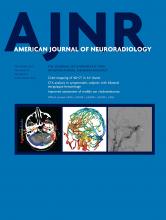Abstract
BACKGROUND AND PURPOSE: Working memory impairment is one of the most troubling and persistent symptoms after mild traumatic brain injury (MTBI). Here we investigate how working memory deficits relate to detectable WM microstructural injuries to discover robust biomarkers that allow early identification of patients with MTBI at the highest risk of working memory impairment.
MATERIALS AND METHODS: Multi-shell diffusion MR imaging was performed on a 3T scanner with 5 b-values. Diffusion metrics of fractional anisotropy, diffusivity and kurtosis (mean, radial, axial), and WM tract integrity were calculated. Auditory-verbal working memory was assessed using the Wechsler Adult Intelligence Scale, 4th ed, subtests: 1) Digit Span including Forward, Backward, and Sequencing; and 2) Letter-Number Sequencing. We studied 19 patients with MTBI within 4 weeks of injury and 20 healthy controls. Tract-Based Spatial Statistics and ROI analyses were performed to reveal possible correlations between diffusion metrics and working memory performance, with age and sex as covariates.
RESULTS: ROI analysis found a significant positive correlation between axial kurtosis and Digit Span Backward in MTBI (Pearson r = 0.69, corrected P = .04), mainly present in the right superior longitudinal fasciculus, which was not observed in healthy controls. Patients with MTBI also appeared to lose the normal associations typically seen in fractional anisotropy and axonal water fraction with Letter-Number Sequencing. Tract-Based Spatial Statistics results also support our findings.
CONCLUSIONS: Differences between patients with MTBI and healthy controls with regard to the relationship between microstructure measures and working memory performance may relate to known axonal perturbations occurring after injury.
ABBREVIATIONS:
- AK
- axial kurtosis
- AWF
- axonal water fraction
- bCC
- body of the corpus callosum
- DKI
- diffusional kurtosis imaging
- DSF
- Digit Span Forward
- DSB
- Digit Span Backward
- DSS
- Digit Span Sequencing
- FA
- fractional anisotropy
- gCC
- genu of the corpus callosum
- HC
- healthy control
- LNS
- Letter-Number Sequencing
- MTBI
- mild traumatic brain injury
- pCR
- posterior corona radiata
- sCC
- splenium of the corpus callosum
- sCR
- superior corona radiata
- SLF
- superior longitudinal fasciculus
- WMTI
- white matter tract integrity
- WAIS
- Wechsler Adult Intelligence Scale
- WRAT
- Wide Range Achievement Test
- © 2019 by American Journal of Neuroradiology
Indicates open access to non-subscribers at www.ajnr.org












